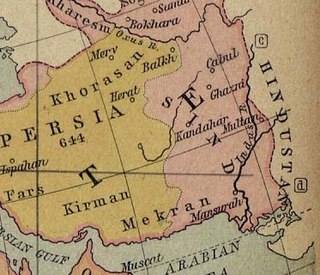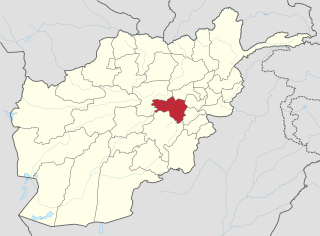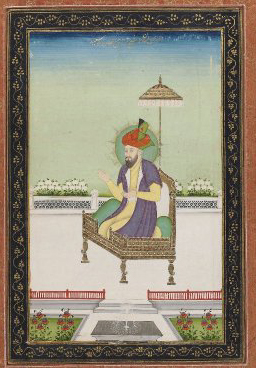Related Research Articles

Sultan Husayn Bayqara Mirza was the Timurid ruler of Herat from 1469 until May 4, 1506, with a brief interruption in 1470.
Tughlugh Timur Khan (1312/13–1363) was the Khan of Moghulistan from c. 1347 and Khan of the whole Chagatai Khanate from c. 1360 until his death. Esen Buqa is believed to be his father. His reign is known for his conversion to Islam and his invasions of Transoxiana.
The Arghun dynasty ruled over the area between Southern Afghanistan and Sindh from the late 15th century to the early 16th century. Arghun rule can be divided into two branches: the Arghun branch of Dhu'l-Nun Beg Arghun that ruled until 1554, and the Tarkhan branch of Muhammad 'Isa Tarkhan that ruled until 1591.

Kamran Mirza was the second son of Babur, the founder of the Mughal Empire and the first Mughal Emperor. Kamran Mirza was born in Kabul to Babur's wife Gulrukh Begum. He was half-brother to Babur's eldest son Humayun, who would go on and inherit the Mughal throne, but he was full-brother to Babur's third son, Askari. A divan written in Persian and Chagatai is attributed to him.

Farrukh Beg, also known as Farrukh Husayn, was a Persian miniature painter, who spent a bulk of his career in Safavid Iran and Mughal India, praised by Mughal Emperor Jahangir as "unrivaled in the age."
Mirza Muhammad Haidar Dughlat Beg was a Chagatai Turco-Mongol military general, governor of Kashmir, and a historian. He was a Mughal Dughlat prince who wrote in both Chaghatai and Persian languages. Haidar and Babur were cousins on their mother's side, through the line of Genghis Khan. Unlike Babur, Haidar considered himself more of an ethnic Mongol of Moghulistan.

In 1504, Babur besieged Kabul and took the city from the Arghuns under Mukim Beg Arghun, to become the new king of Kabul and Ghazni regions. The territory gave him respite from his Uzbek troubles in Central Asia. It allowed him to build his nascent kingdom into a strong and formidable power in later years, enough to conquer northern India.
Muhammad Khan was a son of Khizr Khoja and was Khan of Moghulistan from 1408 to 1415.

In the early 16th century, Sultan Mahmud Khan, the Chagatai Khan of Western Moghulistan, and Sultan Ahmad Alaq Khan, the Chagatai Khan of Eastern Moghulistan, decided to counter the growing power of the Uzbeks under Muhammad Shaybani. Sultan Ahmed Tambol had rebelled against his Timurid master Babur and declared his independence. But when Babur tried to reconquer his territory with the help of his uncles, Ahmed Tambol sought the assistance of the Uzbeks. The two Moghul brothers united their forces and launched a campaign against Tambol, but Muhammad Shaybani surprised the Khans and proved victorious in battle of Akhsi and took them both prisoner.

In January 1505, Babur set out from Kabul towards India and proceeding by way of Badam Cheshmeh and Jagdalak reached Adinapur (Jalalabad). Nasir Mirza, his younger brother, joined him here. As the Aimaqs of that neighborhood with their followers had moved down with all their families into Lamghanat for the purpose of wintering there, they waited for this group and others till they were joined by them after which the army went on to Kush Gumbez lower down than Jui Shahi. Nasir Mirza having made some provision for his dependents and followers from the country under his government stayed behind at Kush Gumbez promising to follow in two or three days.

Battle of Ab Darrah Pass was the battle that took place in 1511 in the place called Ab Darrah between Uzbeks and Babur of Timurids. The battle ended with the decisive Timurid victory which enabled Babur to regain Transoxiana and briefly reunite the whole of the ancestral part of the Timurid Empire. Such a decisive and significant battle is not mentioned in Babur’s Memoirs (Baburnama), in which there is a break from the year 1508 to the beginning of 1519.
Eastern Afghanistan Operations was when Uzbek Khan and Muhammad Shaybani surrounded Kandahar, Babur found his developing Kingdom of Kabul in danger. He feared that Kabul would be the next target of the Uzbeks. Having consulted with his men, he decided the only way out was to leave to India. Babur's second Indian expedition, became an operation monitoring Kabul, traveling around eastern provinces of Afghanistan to subdue rebellious Afghans and plunder towns and villages for supplies for his army's survival.

After the conquest of Kabul, Babur had imposed a large contribution of horses and sheep on the Sultan Masudi Hazaras and sent collectors to receive it. However, his collectors returned unsuccessful. The Hazaras refused to pay as they did not recognize Babur as their legitimate sovereign. Several times before they had been guilty of depredations on the roads of Ghazni and Gardez. Babur decided to subdue the Hazaras in what is now Maidan Wardak Province of Afghanistan.

Umar Shaikh Mirza II was the ruler of the Fergana Valley. He was the fourth son of Abu Sa'id Mirza, the emperor of the Timurid Empire in what is now Kazakhstan, Uzbekistan, Afghanistan and eastern Iran.
Badi' al-Zaman Mirza was a Timurid ruler of Herat from 1506 to 1507. He was the son of Husayn Bayqarah, who was a great-great-grandson of Timur.
The First Campaign against Turkoman Hazaras was a Mughal Empire campaign against Hazaras in the 16th century. Following Babur's departure from Kabul for Qalat, the Hazaras took advantage of his absence to raid his territories. After Babur had returned to Kabul from his victory at the Battle of Qalat, he remained encamped in the Chaharbagh during the harsh winter of 1505 CE where he planned to make an excursion against them. He then went into Kabul city into the palace of Ulugh Beg Mirza, called Bostān-Serāi, prepared for the campaign and set out from there on December 28, 1505 CE.

Khanzada Begum was a Timurid princess and the eldest daughter of Umar Shaikh Mirza II, the amir of Ferghana. She was also the elder sister of Babur, the founder of the Mughal Empire. She and her brother remained deeply attached to each other all their lives, a period during which the family progressed from ruling a tiny and obscure principality in Central Asia to ruling a large portion of the Indian subcontinent. Babur conferred on his sister, the honorable title of Padshah Begum and she was really the first lady of his Empire after his death.
Sultan Mahmud Mirza was a prince of Timurid branch of Transoxiana, son of Abu Sa'id Mirza.
Alvand Mirza is a member of the Qara Qoyunlu dynasty, the son of Iskandar Kara, the ruler of Mosul, Diyarbakir, and Asadabad. The people from the marriage of his son Pirguli Beg and Khadija Begim, the granddaughter of Jahan Shah from Yusif Mirza, founded the Indian branch of the Qara Qoyunlu dynasty.

Shah Shuja Beg Arghun was the first Arghun ruler of Sindh as he overcome and defeated Jam Feroz, the last ruler of the Samma dynasty, in 1520 and settled himself as the Shah of Sindh. His reign was short-lived as he died in the year 1524. His eldest son, Shah Husayn Beg Arghun succeeded him as the second and last Arghun ruler.
References
- Baburnama - Autobiography of Mughal Emperor Babur
- Tarikh-i-Rashidi - A History of the Moghuls of Central Asia